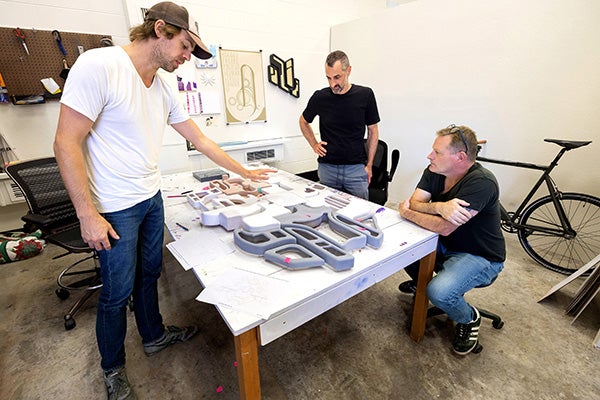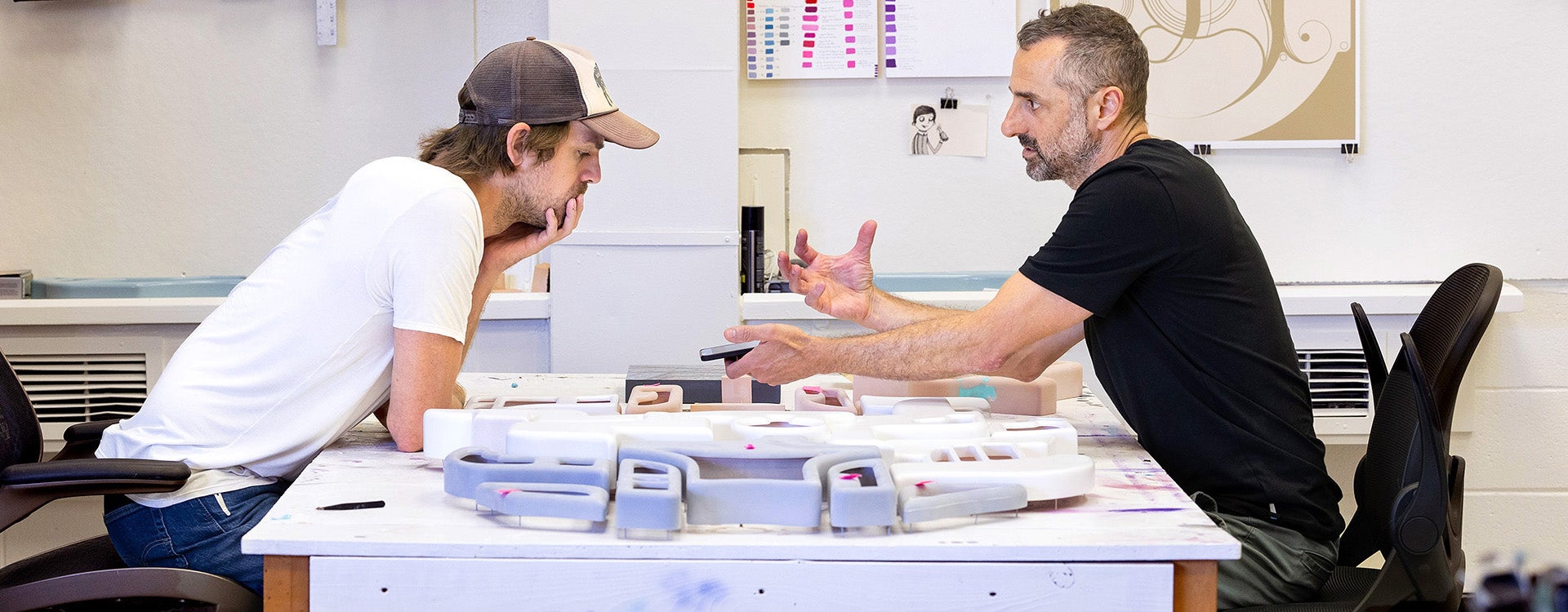Meaning in making: ECU students turn everyday objects into art
Earlier this week, visiting scholar Neil Nenner challenged East Carolina University graduate students to go outside the School of Art and Design and photograph things they normally wouldn’t.
The exercise not only captured images, but also the creativity of ECU students, who worked in mediums across disciplines to delve into what it means to make art during a weeklong workshop.

Third-year East Carolina University graduate student Chris Zidek, left, discusses his artwork with industrial designer and visiting scholar Neil Nenner, center, and ECU faculty member Gerald Weckesser in the Jenkins Fine Art Center. (ECU photos by Rhett Butler)
Nenner, who teaches industrial design at Shenkar University Engineering, Design and Art in Tel Aviv, Israel, was invited to the school after meeting art faculty member Gerald Weckesser, who was teaching a boat building class at Penland School of Craft last summer. Nenner liked the class so much that he worked with his university to bring Weckesser to Israel, where the pair led 30 industrial design students divided into four or five teams to build seven boats in seven days. The two discussed Nenner coming to ECU, which was made possible this semester by School of Art and Design Director Kate Bukoski and College of Fine Arts and Communication Dean Linda Kean.
Nenner said he hoped to give students as much as he could while at ECU. “If you want to learn, especially in our field, you have to do something,” he said. “I don’t want to give them lectures. I just want to provoke them, and I want to give them some processes that they don’t know — to take them out of their discipline, to work with different materials, and take them out of the purpose of craft, and only focusing on the art.”
In another exercise, students were asked to develop a concept, write down words related to the concept and identify common objects related to the words. After that, they chose and disassembled the object, then put it back together in a new way.
Kate Davis, a first-year graduate student in ceramics from Augusta, Georgia, used a roll of tape as her object. This inspired her next theme, “things that come on rolls,” like tape and string, which she made into a wind chime. She said working with Nenner has encouraged her to make pottery without overthinking the process.
“I think more than anything, it’s caused me to loosen up on how I work. I usually work in a really tight way, with really specific chemistry, exact measurements, and this just got me to just start working. I’ve appreciated that,” she said. “I usually overthink it, decide everything in advance, and if it doesn’t go according to plan, that project’s kind of over and I’m starting over. I’m not going to do that now.”
Davis makes her own crystalline glazes that require a controlled firing schedule. Her art is designed to show off the crystals. “They’re really round, really smooth (objects). Sometimes I get multiple bumps on the surface, just a gentle slope in and out for the crystals to flow over,” she said.
She’s planning to work with other firing practices with salt, soda and wood.
Those student experiences were exactly the kind that Weckesser and Nenner hoped for.
“The idea was to invite grad students in and to have them move from a concept or an idea into an object that starts to communicate some of those notions that we started with,” Weckesser said. “Moving from idea to object is a different way to communicate. We might have a thought and intention toward something, but as we move that idea from abstract to concrete, the viewers may come to that object with their own story. And so there’s a fragmentation of the idea, a blossoming, in a lot of other directions.
“We want our students to play with it and have fun. I think the fastest way to have that conversation is to start doing,” Weckesser said.
It was Nenner’s first time teaching in the United States, although he has previously taught in China and at several universities in Israel.
No matter where the students are, Nenner said, he asks students what they want to learn. They always say, “Teach me how to take an idea and make it into art or design,” he said. “They want to learn the process from an abstract idea to a physical object. This is very basic, and it’s in the core, I believe, of all disciplines.”
While at ECU, Nenner presented on his artwork and exhibits back home and led daily sessions with 23 graduate students in a range of concentrations: painting, ceramics, graphic design, metals, textiles, photography and printmaking. Weckesser said they plan to build on the photographic exercise and make it a longer running curatorial activity.

Zidek talks with Nenner, a visiting scholar from Israel.